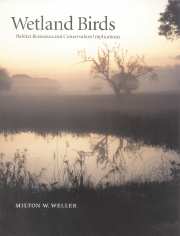Book contents
- Frontmatter
- Contents
- List of plates
- Preface
- Acknowledgments
- 1 Introduction
- 2 Wetlands: what, where, and why
- 3 Major groups of birds that use wetlands
- 4 Water and other resource influences
- 5 Foods, feeding tactics, strategies, and guilds
- 6 Bird mobility and wetland predictability
- 7 Other behavioral and physical influences on wetland living
- 8 Spatial and structural patterns
- 9 Habitat dynamics: water, plant succession, and time
- 10 Population consequences of wetland abundance and quality
- 11 How birds influence wetlands
- 12 Conservation implications
- 13 Measures of bird habitat use and quality
- 14 Current status and some conservation problems
- 15 Conservation and management strategies
- 16 Outlook
- 17 Epilogue
- Appendix 1 Scientific names of birds and bird groups
- Appendix 2 Scientific names of animals and animal groups other than birds
- Appendix 3 Scientific names of plants and plant groups
- Index of birds and bird groups
- Subject index
4 - Water and other resource influences
Published online by Cambridge University Press: 02 October 2009
- Frontmatter
- Contents
- List of plates
- Preface
- Acknowledgments
- 1 Introduction
- 2 Wetlands: what, where, and why
- 3 Major groups of birds that use wetlands
- 4 Water and other resource influences
- 5 Foods, feeding tactics, strategies, and guilds
- 6 Bird mobility and wetland predictability
- 7 Other behavioral and physical influences on wetland living
- 8 Spatial and structural patterns
- 9 Habitat dynamics: water, plant succession, and time
- 10 Population consequences of wetland abundance and quality
- 11 How birds influence wetlands
- 12 Conservation implications
- 13 Measures of bird habitat use and quality
- 14 Current status and some conservation problems
- 15 Conservation and management strategies
- 16 Outlook
- 17 Epilogue
- Appendix 1 Scientific names of birds and bird groups
- Appendix 2 Scientific names of animals and animal groups other than birds
- Appendix 3 Scientific names of plants and plant groups
- Index of birds and bird groups
- Subject index
Summary
Habitat needs for all birds include similar resources: water for drinking and bathing, food, cover for protection from the elements and potential predators, and undisturbed space for meeting social and other life functions. But each group of birds adapts to general features of their typical habitat and exploits its particular resources. Obviously, the unique and dominant feature for wetland birds is water, and long-term adaptations include genetically selected modifications in anatomy, morphology, and physiology (Table 1.1). Shorter-term adjustments involve mostly behavioral changes, but we know little about these and they are difficult to study and test experimentally. Birds, like many wetland animals, often are not truly water adapted but retain terrestrial adaptations that allow them to survive with extremes of water regimes and also to exploit resources of both habitats along the wetland edge.
Migratory, or at least mobile, birds obviously have greater flexibility in their search for habitat than do flightless, terrestrial vertebrates. It has been suggested that birds logically should follow a hierarchy of selection from large to smaller scale. First, on the largest scale, they either reside in or migrate to large geographic regions with climatic regimes and general landscape or vegetation features attractive to them (either via instinctive preferences or prior experience). Second, a bird could select from various landscape alternatives within this geographic region, such as areas showing certain types, spatial relationships, or sizes of wetlands. Third, a single wetland or complex that provided suitable habitat might be the focus of the bird's search for that season or function (e.g., breeding, nonbreeding, feeding, roosting), and, finally, selection of microhabitats, foraging sites, nest site, etc. within the chosen wetland or wetland complex will be made to meet its needs.
- Type
- Chapter
- Information
- Wetland BirdsHabitat Resources and Conservation Implications, pp. 49 - 62Publisher: Cambridge University PressPrint publication year: 1999



